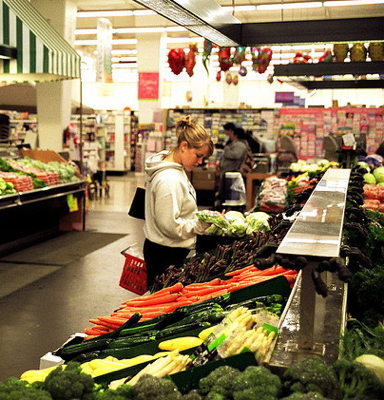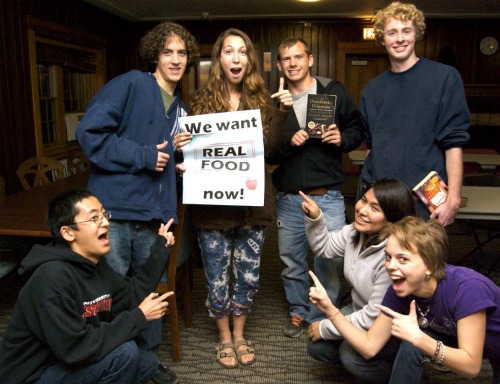 Photo: Christopher Cotrell Four years ago, a coalition of agribusiness companies and industry groups, including Monsanto, the American Farm Bureau, the Midwest Dairy Council, and the National Pork Producers Council, got together to start the Center for Food Integrity (CFI), a nonprofit organization whose mission is “to build consumer trust and confidence in today’s food system.”
Photo: Christopher Cotrell Four years ago, a coalition of agribusiness companies and industry groups, including Monsanto, the American Farm Bureau, the Midwest Dairy Council, and the National Pork Producers Council, got together to start the Center for Food Integrity (CFI), a nonprofit organization whose mission is “to build consumer trust and confidence in today’s food system.”
CFI fulfills its mission by performing market research and then concocting spinmeister Frank Luntz–style message testing to come up with ways Big Food can convince Americans to stop worrying and love industrial agriculture.
But perhaps it’s Big Food that has reason to worry: There’s new evidence that eaters are rapidly losing confidence in the food industry. And that evidence comes to us thanks to CFI’s own data. The group just released its 2011 Consumer Trust Survey [PDF]. Here’s the essence:
[C]onsumers aren’t sure today’s agriculture still qualifies as farming. Why? Generational and geographic distance between farmers and consumers, technological advances in farming, and changes in farm size and structure. We see consumer alienation from agriculture and the food system expressed through concerns about nutrition, food safety, affordability, environmental sustainability, animal welfare, and other issues.
Oops. Is it any wonder that the largest commercial farm groups got together to start the U.S. Farmers & Ranchers Alliance (now a CFI sponsor) in hopes of improving their image among consumers? CFI has some advice on that approach as well, taken from its PowerPoint summary of the research. When it comes to changing consumers’ minds about industrial ag, they say “there is no silver bullet”:
No single program or initiative will reverse the growing trend of consumer alienation from today’s farms.
This sense of alienation is mostly a response to industrial-scale farms. CFI tested the difference in consumer attitudes toward two farming styles and found that, while consumers by and large thought family farmers shared their values, they believed commercial farmers did not.
For example, according to the CFI survey, consumers consider the top issues for agriculture to be:
1. Safe food
2. Affordable food
3. Nutritious food
4. Food grown in ways that reduce the use of herbicides and pesticides
5. Humane treatment of farm animals
I want to give credit where credit is due: That’s a pretty good list! And while those items represent their own priorities, consumers think that industrial farmers instead put profits and productivity above all.
The study’s most interesting result came from consumers’ views on “feeding the world” — a growing concern considering we just reached the 7 billion mark globally — and the justification for much of Big Food’s defense of chemically intensive, high-yield industrial agriculture.
Do consumers want to feed the world? Survey says: not so much.
And before you conclude that Americans are feeling their inner Scrooge during the Great Recession, dig a little deeper into the CFI report and you’ll find some fairly nuanced views. On the one hand, 55 percent agree that America “has a responsibility to provide food for the rest of the world.” But, echoing sustainable agriculture and international development experts, an astonishing 95 percent of respondents believe that “it is more important for the U.S. to teach developing nations how to feed themselves than to export food to them.” Apparently, the “teach a person to fish” proverb resonates with consumers in a way that it does not with food company executives.
Indeed, given that our agricultural sector is export-driven, that response alone should make food company executives sit up and take notice. But it gets better. Just as we at Grist have been discussing at length, 90 percent of respondents agreed that “world hunger is more a matter of food distribution than exporting food from the U.S.”
Well, heck. Good on ya, American consumers!
But it all boils down to much more than the wisdom of crowds. As CFI CEO Charlie Arnot observed in the report summary, this frame poses a problem for Big Ag since the “feed the world” concept is crucial to the entire logic of industrial agriculture:
If consumers don’t believe U.S agriculture has a responsibility to feed the world, then we can’t build consumer support for today’s farming simply by claiming we need to feed more people.
So don’t be surprised if we start to hear more and more about the desperate importance of “feeding the world.” Big Ag needs you to believe it.
Another subject the survey covered that is also near and dear to food reformers’ hearts is the question of the health benefit of organic food. Not only did CFI find overwhelming belief among consumers that organic is better for you, but they found that support had risen almost 10 percent since last year. Is it possible that consumers could be paying attention to the research that suggests as much?
One area of particular concern for the survey authors, however, involved farm animals. It’s not so much that consumers care about humane treatment of animals — they overwhelmingly do — but CFI also found a slight decrease from last year in the number of consumers who are comfortable eating meat, milk, and eggs at all.
The study’s analysis notes that 51 percent strongly agree that they have “no problem” eating meat and dairy. It’s still a majority, but the number is down a full 12 percent since 2007. The trend suggests that by 2012, less than a majority of consumers will strongly agree that eating animals or animal products is okay. Are Americans getting ready to let their vegan flag fly? Maybe not, but it’s promising that consumers are even thinking about the question carefully.
Of course, the survey results are only one part of CFI’s mission. The other part involves coming up with messaging that will achieve continued world domination for Big Food. Here’s where things get a little dubious.
Take CFI’s advice to Big Food on how to make more consumers support genetically modified seeds, for instance. They suggest saying that “genetically modified seed has allowed farmers to increase crop yields, decrease pesticide and fuel use, and lower greenhouse gas emissions.”
The first two claims are false. The third is possible and the last is unlikely. The research on industrial agriculture’s carbon impact is unsettled, but measuring greenhouse-gas emissions from conventional agriculture is notoriously difficult (in large part because no one really knows to what extent excess nitrogen fertilizer turns into nitrous oxide, a powerful greenhouse gas). It’s a shame to see the industry is being counseled to rely on spin like this to garner support.
Many of the other messages involve misdirection and scare tactics — like pointing to extreme studies such as those that project the impact on food prices and hunger if farming today were no more productive than it was in 1950 or studies that postulate a partial or total withdrawal of pesticides from the market. The clear implication is that reformers want to send agriculture back to the dark ages rather than forward to our glorious, genetically modified future.
Other messages involve flawed logic, like their advice to respond to questions about the overuse of antibiotics by pointing out that the antibiotics in use are government approved for use in animals. Um, okay: That’s like saying FDA-approved drugs like Oxycontin can’t be abused because, well, they’re FDA approved.
If nothing else, CFI has given food reformers useful insight into how Big Food approaches many of the most heated food debates. And given the general weakness of the new messaging CFI is providing, the most important message in the survey may be this: In the battle over the hearts and minds of consumers, the good food movement might just be winning.




